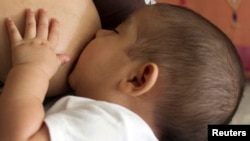From VOA Learning English, this is Science in the News.
I’m Christopher Cruise.
And I’m June Simms.
Today, we explore how intelligence develops in babies. We look at when and how babies learn, and the importance of early contact with languages...
Do Babies Begin Learning Even Before Birth?
Not long ago, many people believed that babies only wanted food and to be kept warm and dry. Some people thought babies were not able to learn things until they were five or six months old. But doctors in the United States now say babies begin learning on their first day of life, and even before birth.
The Eunice Kennedy Shriver National Institute of Child Health and Human Development is a federal government agency. The Institute says babies are strongly influenced by their environment. It says a baby will smile if his or her mother does something the baby likes.
A baby learns to get the best care possible by smiling to please her mother or other caregiver. This is how babies learn to connect and communicate with other people.
The researchers say this ability to learn exists in a baby even before birth. They say newborn babies can recognize and understand sounds they heard while they were still developing inside their mothers.
Study: Baby, Sit Up and You'll Learn Better
Recently, an American study of 112 babies found they learned better when they were sitting up, not lying down. The babies appeared to learn better whether they were sitting up on their own, sitting in seats or helped to sit up.
Researchers with North Dakota State University and Texas A&M organized the study. The researchers say sitting up had what they called a “profound” and “significant” effect on the babies’ ability to learn about objects. They say the body position may be linked to development in the brain.
One organizer of the study says babies can pay more attention to exploring an object if they do not have to worry about balancing themselves. A report on the study appeared in the journal Developmental Psychology.
Underweight and Iron Deficient Babies May Suffer in Long-Term
Underweight babies born with a shortage of the mineral iron may develop problems with thinking and behavior. Studies have shown that adding iron to the babies’ food prevents developmental problems in more than one-third of those born with an iron deficiency.
Magnus Domellof heads the pediatrics department at Umea University in Sweden. He says low birth-weight babies -- those weighing from 2,000 to 2,500 grams -- look normal. Yet about 30 percent of them are iron-deficient at six months of age. Mr. Domellof says 10 percent of them develop a condition called iron-deficient anemia. He says that as the children get older, iron deficiency can lead to behavioral disorders compared to babies treated with iron supplements.
Mr. Domellof and his team studied 285 low-weight newborns. They gave the babies iron droplets every day for six months. Another group of 90 infants received drops of sugar water that contained no iron.
The boys and girls were examined three years later. Only three percent of those who got iron drops showed behavioral and cognitive problems. But 13 percent of those who got the sugar water had problems. The lack of iron did not seem to affect the results of intelligence tests taken by the children.
Mr. Domellof admits his study involved a small number of children. But he says it is the first study to show a direct link between iron deficiency and development-related attention and emotional problems in low birth-weight babies. He says such babies are often ignored in research because they do not appear to have problems.
“They are about five percent of all infants in the U.S. They are quite often neglected in studies, even though the, the few studies that have been performed actually show that these babies are at increased risk for behavioral problems, for cognitive problems, school problems, like that.”
Mr. Domellof says even if a breast-feeding mother is taking iron supplements, that iron does not pass to her child through her breast milk. Iron-deficient children must take iron supplements directly with their food. He plans to examine the boys and girls from the earlier study in a few years to see if their intelligence test results have been affected.
The World Health Organization says iron deficiency is the most-common micronutrient disorder worldwide. WHO officials also say iron deficiency is a leading cause of anemia. About two billion people suffer from the disorder, and 40 percent of preschool-children are believed to be anemic. Low iron levels are partly involved in 20 percent of maternal deaths.
The report on low birth-weight babies was published in the journal Pediatrics.
Birth to Three Years An Important Time for Brain Development
Experts say the first three years of a child’s life are the most intensive period of language and speech development. This is the time when the brain is developing. Language and communication skills are believed to develop best in an environment that is rich with sounds and sights. Experts say children should repeatedly hear the speech and language of other people.
America’s National Institutes of Health says evidence suggests there are important periods of speech and language development in children. The ability to learn a language will be more difficult if these periods pass without early contact with a language.
The first signs of communication happen during the first few days of life, when a baby learns that crying will bring food and attention. Research shows that most children recognize the general sounds of their native language by six months of age. By that time, a baby usually begins to make sounds. These sounds become a kind of nonsense speech over time.
By the end of their first year, most children are able to say a few simple words, although they may not understand the meaning of the words. By 18 months of age, most children can say between eight and 10 words. By two years of age, most children are able to make simple statements. By ages three, four and five, the number of words a child can understand quickly increases. It is at these ages that children begin to understand the rules of language.
Research Says Growing Up in a Bilingual Home a Benefit to Babies
Some children grow up in homes where more than one language is spoken. Understanding two languages can help children as they grow older. However, studies showing there is a more immediate effect of bilingualism on babies’ brains.
Researchers at the University of Washington organized one of the studies. They measured brain activity to compare babies in bilingual families to those in homes where just one language was spoken. Researchers called these single language families, “monolingual” homes.
The researchers studied babies who were between six and 12 months old. The babies were not yet saying words in any language. The youngest monolingual babies were able to recognize a difference between a language used at home and another language. But by 10 to 12 months of age, the monolingual babies were not identifying the sounds of the second language -- only the main language spoken in their home.
By comparison, the bilingual babies did not differentiate sounds of different languages spoken to them between the ages of six and nine months. But between 10 and 12 months, they could identify the different sounds of both languages.
Study: Link Between High-Quality Child Care and Better Test Results
Another study has shown the effect of early education on future learning abilities. The study followed more than 1,300 children from birth through the ages of 10 or 11. It found that children who received higher-quality care before starting school had better language skills by those ages than children who had lower-quality care.
The study is said to be the largest, longest-lasting and most-complete study of child care in the United States. The children studied were born around 1991 in 10 areas. Researchers examined the quality and amount of child care the children received until they were four and one-half years old.
The researchers then examined each child’s performance in school and social development and looked at the quality of classroom education and parenting. They found that the children who had received higher-quality child care showed better ability in tests of language skills.
The study found that the link between high quality child care and better test results continued as the children grew older. It also found that the children’s ability was not dependent on the amount of time they had spent in child care.
This Science in the News was written by Brianna Blake.
Our producer was June Simms.
I’m Christopher Cruise.
And I’m June Simms.
Join us again next week for more news about science on the Voice of America.
We are sorry, but this feature is currently not available
We are sorry, but this feature is currently not available











